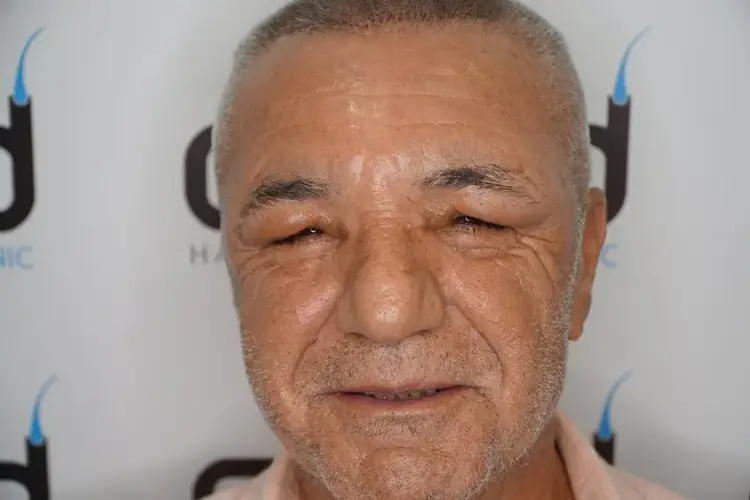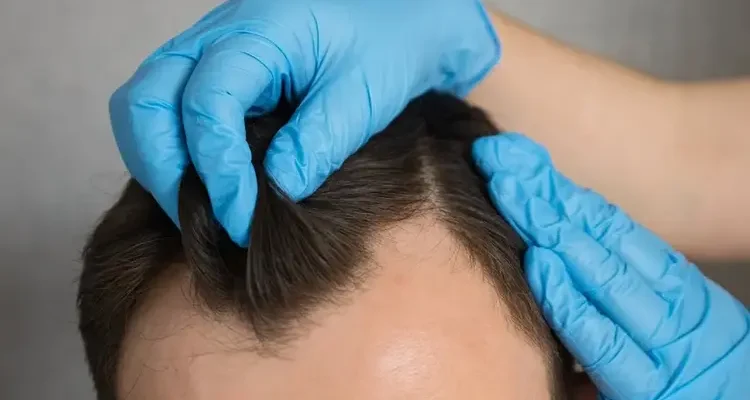Swelling after a hair transplant is a normal condition that occurs in at least half of the patients who undergo the procedure. However, this issue is not adequately explained to patients after the transplant. As a result, many patients perceive the post-transplant swelling as an unexpected and negative situation, leading to anxiety. In reality, this swelling is a common and expected side effect.
After a hair transplant, swelling usually occurs in the forehead area. Depending on the sleeping position, it may extend toward the temples. In rare cases, it can spread to the face and around the eyes, causing temporary bruising on the eyelids. The person may even have difficulty opening their eyes, which can prolong their return to work. However, there is no need to worry—this swelling will subside and will not leave any permanent side effects. In fact, the observed swelling is a normal part of the healing process because it indicates that your body’s defense mechanism is functioning correctly.

Why Does Swelling Occur After Hair Transplant?
There are two main reasons for swelling after the operation. We can explain these reasons as follows.
1) Response to Trauma
Any kind of surgical intervention on the skin is a trauma. In a healthy individual, following trauma, the body’s defense mechanism is activated because it perceives this as an attack on the body. In response to this trauma, the capillaries dilate, increasing blood flow to the affected area. In other words, the body goes into protective mode. Ultimately, the body’s defense mechanism initiates the healing process.
In hair transplantation, the microchannels created by surgical instruments also represent trauma to the skin. The resulting vasodilation, which aids in healing, leads to swelling in the skin. In fact, this swelling is a normal side effect that occurs after any surgical procedure.
2) Local Anesthesia Injection and Fluid Administration in the Transplant Area:
Before the hair transplant, local anesthesia is applied to numb the scalp. In transplants performed using the FUE method, microchannels are created in the anesthetized area. Then, grafts are individually placed into these channels. To facilitate graft placement, an isotonic solution is injected into the transplant area. This expands the opened channels, creating space between the skull and the muscles, making graft insertion easier. Due to both the local anesthesia and the isotonic solution, fluid retention occurs in the scalp. This accumulated fluid, due to gravity, moves downward toward the forehead and eyelids over a few days, leading to swelling known as edema.
In transplants performed using the DHI method, edema is less common. This is because, in this method, channel creation and graft implantation are performed simultaneously. When placing the grafts, there is no need for additional fluid administration beyond local anesthesia. Therefore, one of the two factors causing the swelling mentioned above is eliminated. This can be considered an advantage of the DHI technique.
How Long Does Swelling Last After a Hair Transplant? When Does It Go Away?
Almost every patient may experience some degree of swelling around the forehead after the transplant, whether mild or more pronounced. As we mentioned before, this is a normal occurrence. Swelling usually begins on the 2nd day and becomes quite noticeable by the 4th day. The accumulated fluid will be expelled through the kidneys via urine and will completely disappear after 1 week. In rare cases, it may last up to the 10th day. Along with swelling, there may also be throbbing pain due to tension.
Just as in men, women may also experience swelling in the forehead area after hair transplants. Additionally, in eyebrow transplant procedures, eyelid edema and bruising are common and normal complications.
Degrees of Edema
The main factors affecting the degree of swelling are as follows:
- Skin elasticity
- Patient’s Age
- Number of Grafts and Operation Duration: A high number of grafts means a larger area to be transplanted and a longer procedure time. In this case, the amount of anesthesia and fluids administered will also be higher. Consequently, this leads to an increase in the expected amount of swelling.
- Stage 0: No swelling
- Stage 1: Edema in the upper part of the forehead
- Stage 2: Edema on both the upper and lower parts of the forehead
- Stage 3: Periorbital edema (around the eyelids)
- Stage 4: Bruising on the eyelids (black eyes): Bruises, called ecchymosis, may last up to 10 days.
In Stage 0 and Stage 1, no medical treatment is necessary. The swelling subsides on its own within 2-3 days. In Stage 3 and 4, the patient may not be able to open their eyes, and medical treatment might be required.
Swelling in the Back of the Head After Hair Transplant
During graft extraction, the donor area is numbed with local anesthesia. Then, the donor area is inflated with saline solution to facilitate graft removal. This is a standard procedure in the FUE technique. The accumulated fluid may be felt in the back of the head and neck area starting from the second day. No intervention is needed, as it resolves on its own. Most patients either do not notice the edema in the back of the head or do not report any discomfort.
How to Reduce Swelling After Hair Transplant?
We mentioned above that swelling can sometimes be severe. However, no one wants their quality of life to decline. Everyone wants to return to their normal routine as soon as possible. Some simple precautions can help you get through the swelling in the mildest way possible. Now, let’s briefly look at these simple measures that will help quickly eliminate the edema.
- Sleep with your head elevated: For the first 3-4 days, use two pillows to keep your head at a 45-degree angle while sleeping. This increases fluid circulation in the body and helps reduce swelling faster. Do not sleep face down, as this can increase swelling, prolong recovery, and damage hair follicles due to friction against the pillow. Also, avoid bending your head forward too much in the early days.
- Apply cold compresses to the forehead: Gently press an ice pack or cold towel to the forehead. (Be careful not to apply it directly to the transplanted area.)
- Manual massage: Gently massage the forehead toward the temples with your fingers. This type of massage increases lymphatic drainage and reduces the risk of swelling moving toward the eye area.
- Headband application: Wearing a headband can help prevent swelling from spreading to the face. You can use this method for the first 3 days.
- Drink plenty of fluids: One of the best ways to reduce swelling is to stay hydrated. Aim for at least 2 liters of water per day. This will improve kidney circulation and speed up fluid elimination.
- Reduce salty foods: Cut back on salt in your meals in the first few days, as salt causes fluid retention and can worsen swelling.
- Pay attention to diet: In the early days, avoid spicy and acidic foods. Depending on the season of your hair transplant, consuming green tea, pineapple, or watermelon can help reduce swelling.
- Rest and avoid exertion: Take it easy in the first few days and avoid exercises that may cause sweating.
Ödemin Medikal Tedavisi
In severe swelling cases such as Stage 3 and 4, the recommendations we listed above may not be sufficient, and medical treatment may be required. However, this is a very rare occurrence. In such cases, be sure to contact the doctor who performed your transplant. If severe swelling occurs, corticosteroid-derived medications such as Prednisolone and Dexamethasone will be effective in reducing the swelling.
Some hair transplant surgeons add corticosteroid-derived medications to the local anesthesia solution during the procedure to prevent swelling. This application, called tumescent anesthesia, is an effective solution to prevent swelling. Alternatively, these medications can be taken in tablet form twice a day (morning and evening) for the first 2-3 days immediately after the hair transplant. This is also an effective way to reduce swelling.
Additionally, sudden swelling may occur during the administration of local anesthesia in a hair transplant. This is a very rare complication called anaphylaxis and requires emergency intervention. If your hair transplant is performed by an experienced doctor, they will already have the necessary equipment and emergency response kit for such situations. At AHD Clinic, with our 23 years of hair transplant experience, we have never encountered such an anaphylactic reaction. If you have any allergies to medications, you must inform your doctor before the procedure.
Swelling Persisting for More Than 10 Days
If swelling (edema) continues even after 10 days post-operation, it indicates that something is not right. Excessive burning, fever, and redness along with the swelling may signal an infection. There may also be pimple-like inflammations around the hair follicles. This is a serious condition, and you must contact your doctor immediately for treatment. If necessary precautions are not taken, it may lead to insufficient hair growth and the failure of the hair transplant procedure.
Result:
Although swelling after a hair transplant is actually a normal condition, it is an unwanted complication for patients. You can easily overcome this with the simple precautions mentioned above. We wish you all healthy and hair-filled days.

